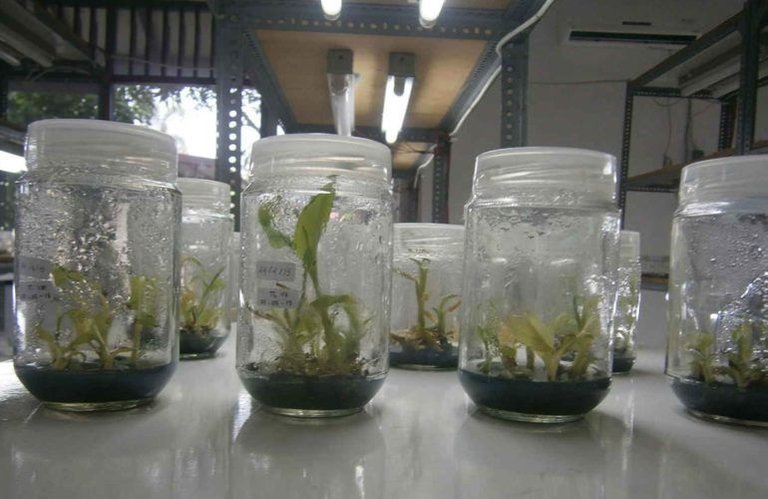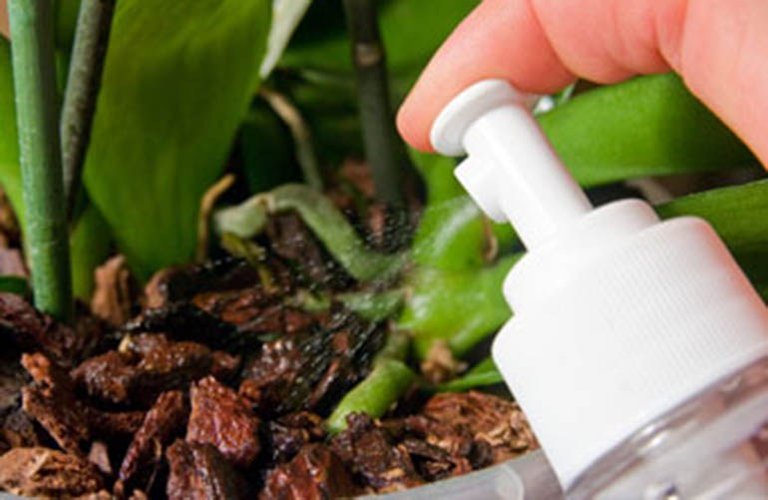
Orchid plants (family orchidaceae) is a plant that naturally lives on other branches of plants, orchids grow wild on hutam in tropical regions that have high rainfall. But in growth orchids can be grown in pots filled with certain media.
Orchid plants can live on planting media such as pot there are several factors that affect, such as environmental factors, sunlight, temperature and humidity and maintenance include fertilizing, watering and control.
- Orchid Plant and Growth Pattern

In its development, the cultivation of orchid plants is divided into 2 types for breeding, the orchid epiphyt and or terrestris orchid orchids. Orchid epiphyt is an orchid plant that lives on attached to other plants but does not interfere with the plant, while orchid terrestris is an orchid plant that lives on fertile humus soil.
While the growth pattern of orchid plants is divided into 2 types of simpodial and monopodial. The simpodial type of orchid is an orchid plant that does not have a main stem, orchids out from the tip of the stem and flowering back from the growing planting child.
Except on the orchid species Dendrobium sp. can release a new flower stalk on the sides of the stem. Examples of simplex orchid types include dendrobium sp., Oncidium sp., Cattleya sp. and cymbidium sp. Simpodial types of orchids are epiphytes in general.
Monopodial orchids are orchids that are characterized by a growing point on the tip of the stem. Growth is straight up on one stem and the flower stalks appear from the sides of the stem between the two armpits of the leaf. Monopodial orchid species include arachnis sp., Vanda sp., Renanthera sp., Phalaenopsis sp., And aranthera sp.

Orchid Cultivation
In orchid cultivation you need to know the right media to grow a good orchid flower in accordance with the type of orchid plant you will plant. The orchid cultivation is actually not complicated, orchid plants can live attached to other plants.
To be more leverage to breed orchid plants, you need to prepare a good planting media and special treatment for the treatment. Here's the technical cultivation.Early Preparation Before Planting
The initial preparation you need to do is prepare a place / environment to grow orchids, prepare planting media for orchid plants, and preparation of orchid plant seeds.
- Orchid Cultivation Environment

A good location for orchid cultivation is the location that has a good intensity of sunlight, the quality of orchid plant growth is affected by the intensity of sunlight obtained. The level of sunlight needs of each type of orchid plants vary, the intensity of light required orchid plants divided into 3 types of needs.
1 . The first needs of orchid plants that must be exposed to direct sunlight. An orchid species suitable for cultivation in the open are vandal orchid plants, arachnis orchids and renanthera orchids.
2 . The second type of need is a type of orchid that can grow well in places that are not exposed to direct sunlight. An orchid species suitable for this condition is orchid ancedium, dendrobium orchid orchid cattleya.
3 . The third type of light needs is an orchid plant that does not like to be exposed to sunlight, so you need to prepare a shade to membudidadayakn this type of orchid plants. This type of orchid plants such as the type of orchid paphiopedilum and orchids phalaenopsis.
To cultivate orchid plants on the needs of the second and third types you must have a special place that has been designed in such a way in order to maximize the growth of orchids you plant. The design of the place can be made a garden on the roof covered with shade net (paranet).
2 . Preparing Good Planting Media
To grow orchid plants there are 2 ways you can do. You can plant orchids on the media pot or affixed to the tree, these two options you can make the choice to cultivate. Better planting medium you choose to adjust the type of orchid itself.
a) .Media Planting Orchids On Pot
Prepare containers / pots in accordance with the characteristics of orchid plants.Pot selection of commonly used small and transparent pots like plastic pots, can also use earthen pots and pots from wood.
The recommendation from me should be to use a clay pot that dipinngirnya there are small holes with a diameter of about 2 cm, so you can better monitor the development of roots and more healthy for orchids.
The disadvantage of clay pots more quickly moss on the pot walls, you should often give it, other options you use transparent pots can be from the plastics, plastic pots are not easily overgrown with moss and you can monitor the development of plant roots.
For growing media of root growth of orchid plants that you can use include fractional tile or red brick, coconut husk, coal, charcoal and can use wood shavings and wooden ferns.
Media planting orchids from fractions of tile / brick

Fraction tile / brick excess is good for attaching the roots of orchids, moisturizer around the roots, and where to store water and nutrient solution. Other advantages of this media is not easy to decay and have drainage and aeration is good enough.
The placement of these two media is placed under pots by filling the 1/3 part of the pot volume. Fractional bricks have greater absorption of tile fraction. But the broken brick more quickly overgrown with moss if it is coated with shards of tile. If the planting medium is overgrown with moss should be replaced with new planting media.Media planting orchids from coconut husk

Media of orchid planting from coconut coir excess has excellent water storage capacity and contains nutrients needed orchid plants. Use of coconut husk choose old age, then cut into pieces adjust the size of the flowerpot.
The weakness of coconut husk decay faster than other planting media material. The technique of its use before it is inserted into the pot is soaked first into the fungicide solution.
This planting media if not used properly stored in a cool and dry place because if used can rot and become a source of orchid plant disease.
3). Preparing the Orchid Seeds
Orchid plant breeding can use 2 ways, that is by conventional way and by way of tissue culture (in vitro culture).
a) .Consultant Orchid Hatchery
The old breeding is subdivided into two types: vegetative and generative.
How vegetative

Vegetative way is by separation or splitting of clumps of orchid plants and then transferred to other planting media.
Seed taken is a bud from the parent plant that already has roots, buds had become a new seed for planting in new planting medium.Generative way

Generative way is the cultivation of orchid seeds from orchid seeds, orchid seeds are very small and do not have endosperm (food reserves). The germination of orchids seeds in the wild is very difficult without the help of mushrooms that symbiosis with the seeds.
If you do a nursery of orchid seeds for the cultivation also takes quite a long time. From seed to tumbut small seeds take about 3 months. After entering the age of 3 months has not been directly transferred to the main pot of orchid plants.
Orchid seeds need to be moved to a rather large pot of 6 cm - 12 cm in diameter. At this time the seeds need routine maintenance such as fertilizing, watering and guarding of pests and insects because it is very susceptible to pests and diseases.
After the seeds grow larger orchids marked the emergence of leaves and appear roots that begin creeping. Approximately after 3 months of the first transfer, at this age orchid seedlings ready to be planted in the main pot diameter of about 12 cm - 20 cm.
b) .Culture of tissue culture orchids (in vitro culture)
In general, tissue culture is defined as a way to multiply the type of plant by isolating certain parts of the meristem tissue. For example, bud or leaf eyes can grow the part on aseptic artificial media, aided by growth regulators.

The main advantage of tissue culture is to obtain new plants in large quantities in a relatively short time. With the tissue culture method the seeds produced have physiological and morphological properties exactly the same as the parent plant. In addition, the seeds produced can also be superior properties.
- Orchid Plant Care
Transfer of Plants to Media Planting
Before making the orchid plant move, you have to prepare the planting media first. Cultivation orchid plants generally use a planting medium with pots of clay.Pots of planting media placed on the shelves of the location of cultivation. In addition, if you want to decorate your cultivation, pots can you hanging with the media wire made like a clothesline.
Pot orchid plants should be placed in the raft or hanging, because if the pot attached directly to the soil surface plant orchids more easily disturbed pests such as snails and snails, other than that aerosi drainage when watering is also not functioning optimally.
Another advantage of placing the plant is stacked or hung that sunlight can penetrate the sidelines of the plant, air circulation can run smoothly. In addition, the growth of moss in the body of the pot can be inhibited.
Orchid plant care is a lot of attention to the quality of planting media used, you need to runting replace the planting medium and pot if it is not feasible. If planting media such as wood fern overgrown with moss, you need to replace the new fern wood.
The goal is to keep the orchid roots healthy. If the growth of orchid roots is also thick, you need to move the orchid plants to a new pot (repotting) and added with more planting medium. This is intended for the growth of orchid plants are not inhibited and can be flowering thick.

Fertilization of Planting Period
Fertilization is good done by spraying, fertilization should also be done on the leaves of orchid plants. Because the leaf vessels in the orchid plants can receive 90% of nutrient intake while the roots only receive 10%.
For lovers of orchid plants, a commonly used fertilizer named dekastar. Dekastar able to accelerate the growth of buds, leaf spreading, stimulate the emergence of flowers and menyburkan plants. In addition dekastar.Dekastar able to accelerate the growth of buds, leaf splash, stimulate the emergence of flowers and menyburkan plants. Besides dekastar for orchid fertilization can use NPK.
Fertilization using NPK has different doses of each plant growth period. The quantity of fertilizer can regulate the balance of vegetative and generative growth of the plant.
In the period of vegetative growth phase of small orchid plants, the ratio of NPK fertilizer is 30:10:10. The vegetative growth rate of medium-sized angrek plants, the ratio of NPK fertilizer is 10:10:10.
While in the generative growth phase that is to stimulate tnaman for flowering, the ratio of NPK fertilizer is 10:30:30.

Fertilization is good done in the morning and afternoon every 3 days once using a plant sprayer (can use a sprayer / nozzle), spray on the leaves and roots of orchids.
Sprinkling
Watering orchids also use spraying techniques (spraying), actually orchids do not like the intake of excessive water because it will make the planting media becomes muddy vulnerable to damage the growth of roots.

Good spraying is on the flowers of leaves and stems to minimize pest attacks and the growth of disease. Orchid flowers if regularly sprayed will bloom with fresh and beautiful, Spraying can be done 2 times a day morning and afternoon before fertilization. In the dry season, watering can be done until 3 times a day, only at night.
thanks, good luck
do not forget to comment and vote
good information
have a good time
Ok friend